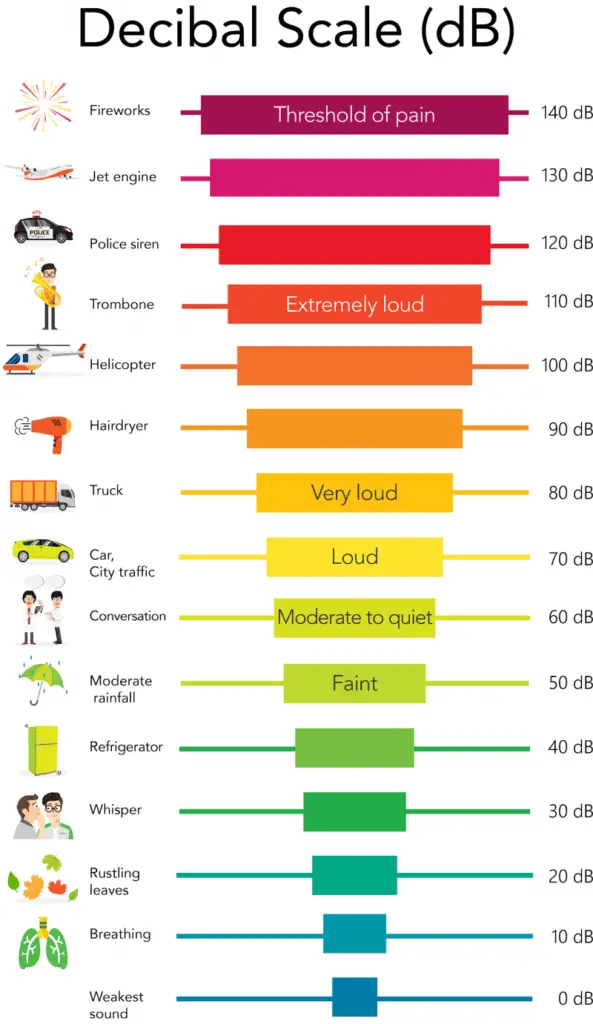In general, anything that makes you feel good is sound, and everything that makes you feel bad is noise.
However, this is the sole difference between sound and noise? No, there will still be a few other considerations.
According to physics, sound is a mechanical wave formed by vibrations in the media through which it travels, and it cannot be seen but can only be felt by hearing.
If you are new to sound technology that is working on any aspects of soundproofing your home, it is important to grasp the distinction between sound and noise.
Before studying the fundamentals of acoustics, I always wondered what is sound and how it differed from noise.
The responses from many sources varied, but I solidified the final concept based on the underlying meaning behind sound and human nature to distinguish sound and noise.
In this article, we will first define sound and noise, and then analyse the key differences between them.
Sound Vs Noise:
What is Sound?
Particle vibrations in a medium like air cause sound to be created.
In which the vibration causes pressure or displacement in the air particles leading to low pressure in some places and high pressure in others.
This air pressure continues to proceed through the air medium, exerting the same pressure on all approaching air particles until it comes into contact with a barrier that causes the flow to stop.
When this air particle-wave pressure strikes the eardrum, it produces the same pressure that the brain perceives as sound waves.
In this manner, the sound is produced as a result of particle vibrations.
The best way to understand sound is to first understand frequency, which determines the pitch of sound waves and is measured in Hertz.
As the frequency rises, the sound will become higher pitched.
Higher frequencies have a substantial influence on hearing loss since the human ear could only detect sound frequencies in the range of 20-20,000 Hz.
Sound is the acoustic frequency that is enjoyable to hear, simple to distinguish, and easy to reproduce.
A pleasant sound is one that originates from a certain frequency or from a single source.
Properties of Sound:
The seven main components of sound determine whether it is perceived by the human ear as noise or melody.
Due to the various characteristics of sound, several kinds of animals have unique hearing that may be inaudible to humans.
Think about the following audio characteristics:
Frequency:
Sound waves are what makeup sound, these waves rise and fall and then rise again, completing a cycle.
The time taken for a sound wave to complete one full cycle is known as the frequency or often known as pitch.
Hertz units are used to measure it, with one hertz (Hz) standing for one cycle per second.
Amplitude:
The term “amplitude” refers to a soundwave’s strength.
The higher the sound waves, the greater the intensity and amplitude.
We call it the loudness of the sound in everyday parlance.
Shouting indicates that the sound has a high amplitude, whereas whispering indicates a low amplitude.
Timbre:
If you ever heard the same note played on two different instruments sounds completely different because their tones or timbres differ.
Lower-pitched frequencies are known as subtones, whereas higher-pitched frequencies are known as overtones.
They combine to generate ‘harmonics,’ which give the music a specific timbre or tone.
Envelope:
An envelope is essential for sound waves or sound behaviour over time.
It is also known as ADSR, which stands for assault, decay, sustain, and release.
These are the envelope’s four sub-properties.
The assault is quickly a sound achieves its maximum level; the decay decreases before maintaining a steady loudness, then released into the atmosphere, virtually disappearing.
Velocity:
The velocity of sound is the rate at which sound waves move through various media.
Since soundwaves travel via the medium of air, their velocity may be affected by a variety of elements such as humidity, temperature, and density.
Wavelengths:
The separation between two adjacent crests determines a sound wave’s wavelength.
The wavelengths of audible sounds are longer than inaudible noises.
Phase:
The separation of two sound waves’ amplitude crests and troughs is referred to as their phase, it is measured in time, degree, or space.
Two sound waves which have the same phase difference and are precisely aligned to each other are said to be ‘in phase.’
To avoid ‘hollow’ sounds, it is critical to understand the phase of the sound.
What is Noise?
The human ear is capable of distinguishing between sounds coming from various sources and determining which sounds are pleasing to him and which ones irritate him.
Based on this ability, anybody may make decisions about sound vs noise.
Consider a situation in which someone is enjoying music at a greater volume than may be unpleasant for you.
However, the person enjoying the music does not find the volume to be loud.
In this article, we have provided the difference between sound and noise, but let me give you another example using the principles of sound engineering.
Previously, we learned that if you hear a sound of a given frequency, you would probably appreciate it, but what if numerous frequencies of sound waves come together to you?
You won’t be able to appreciate any of them since they are a jumble of frequencies with no discernible sound to hear and enjoy hence, they will be classified as noise.
The reason we refer to the noise produced by highway traffic as noise is that it is difficult to identify the exact source of the sound since it is a combination of a variety of sources.
Noise may be amplified further by reflection from numerous sources known as echos.
As a result, we frequently use the A-weighted frequency that is much more sensitive from 500 and 6 kHz.
Types of Noise:
There are four varieties of noise, which are stated below:
Continuous Noise:
As the name suggests, a continuous source of the noise.
The continuous noise is produced by machines that operate constantly without any interruptions, such as when we ride in a car and hear the sound of working parts such as the engine, and in factories, enormous machinery makes continuous noise.
Intermittent Noise:
Intermittent sounds are those that do not occur on a constant basis, they are generated continually but with gaps in between.
Drilling machines are the greatest examples of irregular noises; you may have heard or seen them when a structure was being torn down or built.
They make an intolerable amount of noise.
Drilling devices used by carpenters or dentists are another source of sporadic noise.
Impulsive noise:
it is a form of noise that has a length of one second and a noise intensity of greater than 40 dB during a half-second.
Almost all undesired, harsh noises are included in impulsive sounds.
Bomb blasts, the edge of weaponry, and other abrupt noises are examples.
Low-Frequency Noise:
Low-frequency noise is generated by ordinary things.
One of the hardest noises to silence may register sound pressure levels of 30 to 40 dB in a quiet space.
A heating or ventilation system generates this noise in an office setting, it will be generated by the ticking of a grandfather clock at our home.
We don’t detect different types of noise until we pay attention to them.
Impact of Noise on Health?
If you are consistently exposed to high-level noise, it will have an influence on your physical and psychological health.
Here are a few illustrations that were gathered from various sources.
Hearing loss:
In other words, the human ear’s threshold is typically set between 2000 and 5000 Hz prolonged exposure to louder sounds can lead to shifts as high as 3000-6000 Hz.
This causes tinnitus, a hearing condition in which you hear a sound like clicking, hissing, or roaring even when no external sound is present.
Noise’s Psychological Effect:
Continuous exposure to increased noise causes despair and anxiety, and with a higher level of sound interaction, the personal nature changes to aggressive reactions.
Even if you have a habit of hearing louder noises all the time, it can lead to hearing loss as previously mentioned.
Sleeping Problems:
If your home is near a train track or any other high-traffic location, it will undoubtedly disrupt your sleep and stress your whole day.
According to science, a human mind needs to sleep at least 7 hours every day to have a healthy lifecycle, but this is not feasible in a loud environment.
What is the Difference Between Sound and Noise?

Sound is pleasant in nature and everyone enjoys hearing it for as long as possible despite the fact that Noise is something that is useless and inconvenient in nature.
A sound is a sort of mechanical energy that is simple to duplicate, whereas noise is difficult to duplicate.
Sound follows a certain mechanical wave pattern, whereas noise is a collection of diverse wave patterns that are difficult to distinguish that cannot be reproduced in the exact wave pattern.
The sound is usually in the 20 Hz-5k Hz range and less than 85 dB in intensity, making it easy to detect and pleasant to hear.
Since noise has a tendency to be obtrusive by nature.
It is often greater in strength and higher in pitch making noise that is 85 dB or louder than obtrusive by nature most of the time.
Sound is incredibly beneficial in many ways including human communication, music recording
Many more uses, yet typical noise is worthless in nature.
Also read: Resilient Channel Vs Hat Channel
FAQ- Difference Between Sound and Noise:
Q1. How Do You Deal with Noise?
Nowadays, everyone is concerned about resisting unwanted soundwaves, whether in the business, home, or private space.
So, the best thing people think of when it comes to noise reduction is soundproofing.
Q2. What is the difference between noise and sound in music?
Noise is an unpleasant sound.
The sound of a violin is commonly referred to as music – something nice.
The sound may be interpreted as noise depending on other circumstances.
Noise perception is a personal thing.
Q3: How does sound turn into noise?
Noise occurs when a sound becomes unpleasant to our hearing.
It makes no difference whether the pitch of the sound is low or high.
Also read: Difference between NRC and STC
Conclusion:
Although both sound and noise are made up of sound waves.
When you say, “I heard something nice,” which is audible in nature, you are actually describing the sound, but if you say, “I heard something disagreeable,” you are describing noise.
Always try to avoid using earphones or headphones all day since this could permanently impair the threshold frequency of hearing.
If you have any questions about the guide, please leave a comment, and we will respond as soon as possible.
Section Under: Diff










